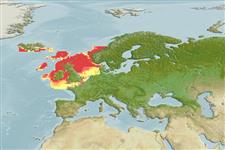Teleostei (teleosts) >
Gobiiformes (Gobies) >
Gobiidae (Gobies) > Gobionellinae
Etymology: Lebetus: Greek, lebes, -etos = small boiler (Ref. 45335).
Environment: milieu / climate zone / depth range / distribution range
Ecology
Marine; reef-associated; depth range 30 - 375 m (Ref. 35388). Temperate; 65°N - 48°N, 24°W - 13°E
Northeast Atlantic: southwest Iceland, the Faeroes and Hemnefjord, Norway, to northern Bay of Biscay.
Size / Weight / Age
Maturity: Lm ? range ? - ? cm
Max length : 4.0 cm SL male/unsexed; (Ref. 35388); max. reported age: 2.00 years (Ref. 35388)
Short description
Morphology | Morphometrics
Dorsal
soft rays
(total): 9-10;
Anal
soft rays: 7 - 8. Distinguished by having the following characteristics: Reduced suckers (Ref. 92840); pelvic disc without anterior transverse membrane (Ref. 35388).
Inhabits mainly on coarse grounds, especially coralline deposits. Occur in caves and other dark habitats (Ref. 92840). Feeds on small crustaceans (decapods, amphipods), polychaetes and bivalves (Ref. 4696).
Miller, P.J., 1986. Gobiidae. p. 1019-1085. In P.J.P. Whitehead, M.-L. Bauchot, J.-C. Hureau, J. Nielsen and E. Tortonese (eds.) Fishes of the North-eastern Atlantic and the Mediterranean. Volume 3. UNESCO, Paris. (Ref. 4696)
IUCN Red List Status (Ref. 130435)
Threat to humans
Harmless
Human uses
More information
Age/SizeGrowthLength-weightLength-lengthLength-frequenciesMorphometricsMorphologyLarvaeLarval dynamicsRecruitmentAbundanceBRUVS
ReferencesAquacultureAquaculture profileStrainsGeneticsElectrophoresesHeritabilityDiseasesProcessingNutrientsMass conversion
Tools
Special reports
Download XML
Internet sources
Estimates based on models
Preferred temperature (Ref.
123201): 6.8 - 10.1, mean 7.9 °C (based on 246 cells).
Phylogenetic diversity index (Ref.
82804): PD
50 = 0.7500 [Uniqueness, from 0.5 = low to 2.0 = high].
Bayesian length-weight: a=0.00977 (0.00442 - 0.02163), b=3.05 (2.86 - 3.24), in cm total length, based on LWR estimates for this (Sub)family-body shape (Ref.
93245).
Trophic level (Ref.
69278): 3.2 ±0.41 se; based on food items.
Resilience (Ref.
120179): High, minimum population doubling time less than 15 months (tmax=2; tm=1-2; Fec=270).
Fishing Vulnerability (Ref.
59153): Low vulnerability (10 of 100).
